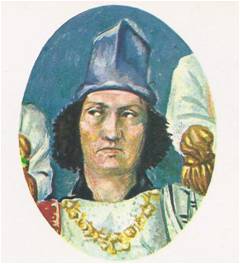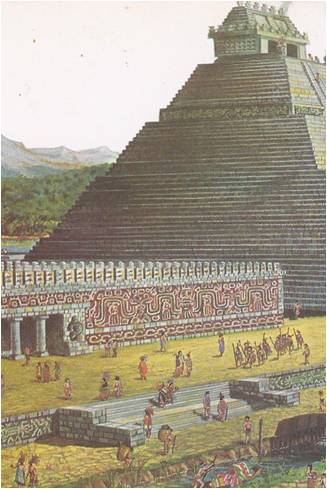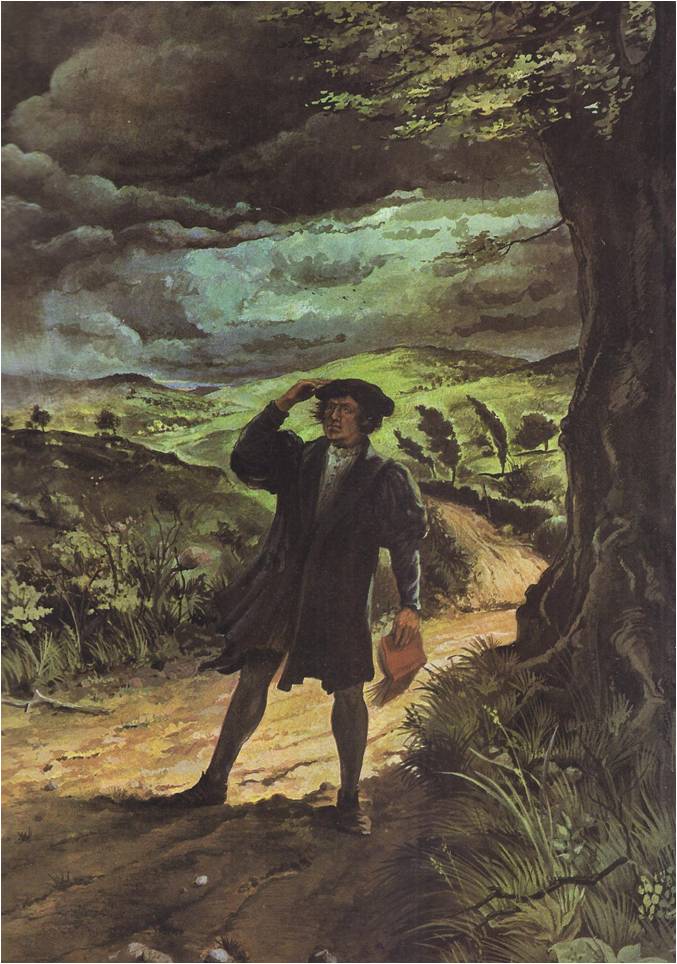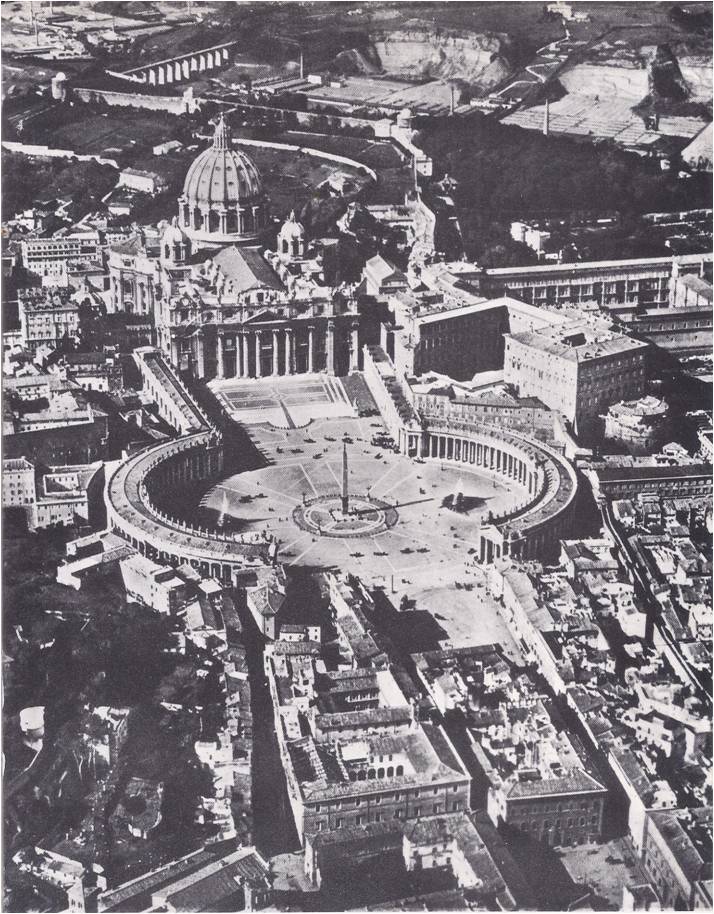There he sat in the great hall in the German city of Worms. His bright eyes and wide forehead gave him an air of distinction. You would not quickly forget that face. Before him was gathered an assembly of high ranking nobles and churchmen from many parts of Europe. For this man was Charles V, Emperor of the Holy Roman Empire, Archduke of Austria, ruler of the Netherlands and half of Italy, as well as King of Spain and master of Spain’s vast possessions in the New World. Yet Charles, who belonged to the famous Hapsburg family of Austria, was only 21 years old when he came to Worms in the year 1521. He had been elected Emperor of the Holy Roman Empire only two years before and he hoped to settle many pressing problems in conference with the assembled notables. Perhaps it was just as well for the young monarch that he could not look into the future. Perhaps it was fortunate that he could not foresee some thirty-five years of struggle within his empire. He did not know that he would be fighting French men and Italians and Turks, as well as the Protestants of his own empire. Nor is it likely that in 1521 Charles V would have believed that the time would ever come when he would gladly and freely hand over his vast powers and lands to others. Yet after a reign of 37 years Charles told another group of nobles: “I am no longer able to attend to my affairs without great bodily fatigue. . . . The little strength that remains to me is rapidly disappearing. . . . In my present state of weakness, I should have to render a serious account to God and man if I did not lay aside …
Read More »France Becomes a Great Nation 1453-1631
WHEN MORE than a century of war between England and France ended in 1453, it was the French king, Charles VII, who was victorious. Although he had driven the English out of France, Charles found himself the king of a sad land. During the wars the great French nobles had fought among themselves as bitterly as they had fought the English and they had become so powerful that they no longer respected their king. France itself was devastated, the people poor and hungry. Paris had been half ruined. Wolves prowled the city by night and twenty-four thousand houses stood empty. Charles worked hard to restore order, setting aside special hours each day for special problems. He organized a permanent army to make himself independent of the nobles, but he found the nobles had no intention of letting him be independent. Many of them rebelled and his own son Louis joined them. Charles died in 1461 and Louis became king — and before long Louis, too, had trouble with the nobles. One great duke, Charles the Bold of Burgundy, even imprisoned Louis in a castle until the king promised to satisfy all the nobles’ demands. After he was freed, however, Louis broke all his promises. He was astoundingly lucky; one by one his greatest rivals died and he inherited their lands. As he gathered in more lands and more power, Frenchmen grew to fear him. They called him the Spider King. Louis’ successors turned to fighting wars in Europe to win new glory for France. Francis I was so successful that he even hoped to be elected the next ruler of the great Holy Roman Empire. He did his best to buy up the votes of the princely electors, but all his gold could not match the riches of the powerful …
Read More »Adventures in the New World 1519 – 1620
“I DID NOT come to till the soil like a peasant,” said Hernando Cortez. “I came to find gold.” His words echoed the thoughts of almost every Spaniard in the New World. The discovery of the sea route to the West had set off a great treasure hunt. Colonizing and slaughtering, building and plundering, the gold-hungry Spaniards won a Spanish Empire of the West. Conquistadores‚ they were called — the conquerors. None of the treasure-hunters was more cunning or ambitious than Hernando Cortez‚ who came to the island of Hispaniola in 1504. It was not until 1519 that the governor of Hispaniola sent him on an expedition to explore the coast of Central America. Cortez sailed with five ships, 500 soldiers, eleven cannon and fifteen horses. The fleet anchored near the coast of the territory called Mexico and the men went ashore to build a settlement. Cortez ordered the ships dismantled so that none of his men could go back to Hispaniola, then set off on a march inland. Mexico was a vast country whose Indians had built a highly organized civilization and Cortez had a force of less than 500 men. He was a skillful leader; besides, he had firearms and horses –and good luck. Not long after he began his march, a horde of Indians swept out of the hills to attack the Spaniards. As soon as the Spanish cavalry appeared, the Indians fled to safety. As one soldier later wrote, the Indians, “who had never before seen a horse, thought that steed and rider were one creature.” One tribe after another surrendered. They had been conquered by the people called the Aztecs and many of them offered to join Cortez in the fight to destroy the Aztec empire. As the Spaniards and their Indian allies pushed on …
Read More »The Counter Reformation 1521-1648
THE BLAST OF MUSKETS and the clang of swords against armour echoed across the plains of Italy, Spain and the Lowlands. Warriors of the king of France were clashing with the Spanish infantry and German knights of the Holy Roman Emperor. Control of the nations of Europe was the prize both nations sought. They schemed and plotted; their generals planned campaigns; their soldiers marched out to victory or defeat. Victories counted for little, for much of Europe’s future was decided by another, different kind of war – a war for the minds and souls of men. Village squares and royal council chambers, churches, university lecture halls and schoolrooms were the battlefields of this new war. Its troops were armies of preachers whose battle-songs were hymns and whose weapons were Bibles and textbooks. Reformers were on the march, Lutherans and Calvinists. Their thundering voices shook the domes of ancient cathedrals and wakened bishops dozing in their palaces. The Reformers won no easy victories‚ however. The forces of the pope were also on the march and the strongholds of the Church were well defended. Frightened by rebellions in Germany and Switzerland, the Catholic leaders in Rome took further measures to strengthen the Church. “There is but one way to silence the Protestants’ complaints‚” a learned churchman told the pope “and that is not to deserve them.” Lowly monks and the powerful cardinals alike began to talk of reform, of hard work, of honesty and godliness. Gradually there were deeds to match the talk — a great Church house-cleaning that one day would be called the Counter-Reformation. Meanwhile, in Europe’s towns and colleges‚ new soldiers of the Church appeared. Their uniforms were the simple black robes of monks, but their minds were as keen as dueling swords — much too sharp and smooth, …
Read More »The Monk from Wittenberg 1505-1546
ON A SULTRY JULY DAY IN 1505, a young law student, Martin Luther, was walking along a country road in Germany when a summer storm blew up. The air grew heavy and black clouds filled the sky. Before Luther could take shelter, thunder began to crash. A bolt of lightning struck the road almost at his feet. Thrown to the ground, he lay shaking, not certain whether he was alive or dead. “Help me, Saint Anne,” he cried, “help me and I will become a monk.” After a moment, Luther’s trembling stopped. He stood up, found that he was not hurt and continued his walk toward Erfurt, the town in which he attended the university. He did not forget his promise to Saint Anne. He spent a week or so thinking and making plans. Then he told his professors that he could come no more to their classes. He sold his books, bade farewell to his friends and went to the monastery of the Augustinian friars and said that it was his wish to become a monk. When Martin’s father, old Hans Luther, heard what his son had done, he was puzzled and angry. Hans had worked hard all of his life. Though his ancestors had been peasant farmers, he had managed to set himself up in a little business. But he was far from rich; he had scrimped and saved to send his son to school and to the university. He had long looked forward to the time when Martin would be a lawyer, a man of standing who would make his parents proud and earn the money to care for them in their old age. Now those plans were ruined. As a monk, Martin would never win fame or riches. Hans was furious and he wrote to Martin …
Read More »The Renaissance in the North and Spain 1400 – 1598
Through the bustling market-towns of the Low Countries passed the traders, goods and gold of all Europe. Here the luxuries of Asia — spices‚ silks, jewels and perfumes — were exchanged for the practical products of the North — woolen cloth and utensils of iron and copper and wood. In shops and inns, wily Italian shippers and bankers bargained with the solemn, solid merchants from Germany and Flanders — and made the profits that built the Renaissance cities of Italy. In tall-spired cathedrals, in palaces, guildhalls and universities, wandering Italian artists discovered works of art and scholarship as great as any they had known at home. The men of the North had needed no outsiders to teach them about money-making or magnificence. Long before the Renaissance spread across Europe from Italy, they had turned to business, formed the guilds, grown rich and invested their gold in displays of splendour. Flanders was the center of a great cloth-making industry. Germany was the home of expert craftsmen—armourers, goldsmiths and engravers. In Haarlem in the Low Countries, a jack-of-all-trades named Laurent Coster had first thought of using movable carved letters to form words and sentences from which pages could be printed. About 1440, Johann Gutenberg and his assistant Peter Schoeffer had put Coster’s idea to use, made the first printed books and brought about a revolution in learning that changed the history of the world. The northern artists also were inventive and their guildsman patrons kept them as busy as the artists of Italy. Of course, their tastes were not Italian and their paintings and statues, like their ideas, were very different from those in Florence, Milan and Rome. When Masaccio was first teaching the Florentines how to paint figures that “stood on their feet,” the wool merchants of Flanders were buying paintings …
Read More »Rome, the City of the Pope 1492-1564
In 1492, young Giovanni de’ Medici bade farewell to his father, Lorenzo the Magnificent and left Florence to take his place in Rome among the cardinals of the church. At sixteen, Giovanni was a nobleman in the court of the pope, a man of influence and power. That was fortunate, for when Giovanni was eighteen, his family’s power collapsed. The Florentines drove the Medici from their city and Giovanni, who had come home for a visit, narrowly escaped being stoned by the citizens who once had cheered him. As he crept out of the city, disguised as a poor friar, he swore that he would one day return in triumph. First, he thought, he must look to his career in the church. Whatever the Florentines did, he was still a cardinal and in the papal court there were many ways for a clever man to rise to greatness. When he had crossed the Tuscan border, Giovanni threw off his humble disguise, put on the crimson robes and red hat that marked him as a “prince of the church” and took the road that led to Rome. The young cardinal was not alone in hoping to make his fortune in Rome. Indeed, the old city teemed with ambitious men of every sort — scholars and scoundrels, diplomats and spies, millionaires and fortune-hunters, priests and professional murderers. Rome had known every sort of splendour and evil. Memories of unmatched elegance and unbelievable cruelty lingered in the ruins of temples and arenas built by ancient emperors. Grim fortress-houses were reminders of an age of violence, when the bloody feuds of rival clans of nobles had turned Rome into a ghost city. Now there were new mansions, palaces and lofty churches. A new magnificence had come to Rome with the gold that poured into …
Read More »The Hundred Years War 1326-1477
THE LONG STRUGGLE between France and England, known to history as the Hundred Years’ War, was not really a war — and it lasted more than a hundred years. Rather than a war, it was a series of separate battles, with periods of uneasy peace between and it lasted from 1338 to 1453. It was time of misery for both sides, but the French lost more men and saw much of their land devastated. By the end of the Hundred Years’ War, important changes had taken place in both countries. In France, the years of conflict weakened the power of the nobility and led to the rise of a strong middle class. Warfare would never be the same; the English victories showed that mounted knights, weighed down by heavy armour‚ were no match for archers with longbows and the final battles were decided by artillery. The cause of the war was that the English still held the Duchy of Aquitaine, a rich land in southwestern France and were determined not to lose it. The French were equally determined to drive them out. A further complication was the situation in Flanders. The English sold raw wool to Flemish manufacturers, who wove it into cloth and sold a good part of it back to the English. This trade was important to England and even more so to Flanders and both countries were anxious that nothing should happen to disturb it. The English also kept a watchful eye on the Flemish ports, which could serve as a base for a French attack on England or an English attack on the continent. Flanders was not a completely independent state; its ruler, the Count of Flanders, owed allegiance to the king of France. England tried to destroy the count’s authority by stirring up the Flemish …
Read More »







